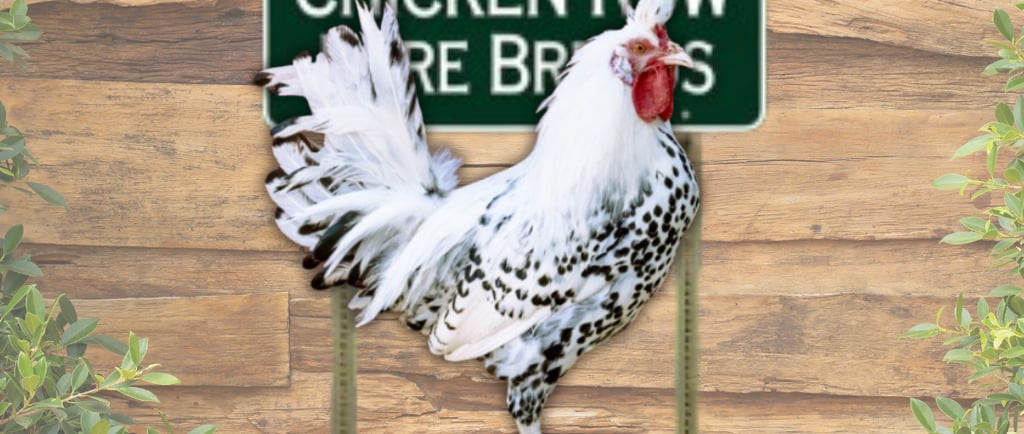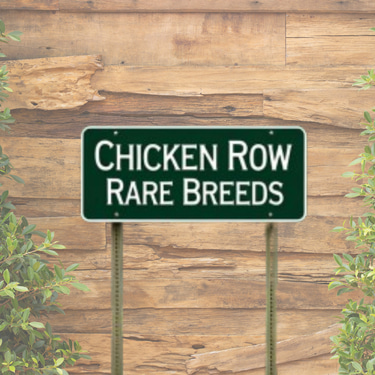Spitzhauben
A rare Swiss heritage breed with a striking crest and lively spirit
8/22/20252 min read


🐓 Spitzhauben: Switzerland’s National Chicken
Elegant, active, and topped with a forward-sweeping crest that looks like a ceremonial hat, the Spitzhauben (also known as the Appenzeller Spitzhauben) is one of the most striking heritage breeds in the poultry world. Originally bred in the 16th century in Switzerland’s Appenzell district monasteries, this chicken is considered the national breed of Switzerland.
📜 A Brief History
The Spitzhauben gets its name from the traditional pointed hats (“spitzhauben”) once worn by women in Switzerland. The breed thrived for centuries, but nearly went extinct after World War II.
In 1953, German breeder Kurt Fischer rescued the Spitzhauben by importing and breeding birds in black, golden spangled, and silver spangled varieties. His work preserved the breed from disappearing entirely.
The silver spangled variety was later introduced to the United States in the 1950s, and today it remains the most common color seen here. While the breed isn’t yet recognized by the American Poultry Association, it is recognized in the UK, and conservation efforts continue to protect it.
📌 Breed Snapshot
Status: Watch (Heritage Conservation Priority List)
Use: Eggs
Egg Production: 150–180 eggs per year
Egg Size & Color: Medium to large; white
Weight: Roosters 4.5 lbs; Hens 3.5 lbs
Temperament: Active, flighty
Characteristics: Distinctive forward crest, excellent forager, winter hardy
🐓 Why Choose a Spitzhauben?
Year-Round Layers
Spitzhaubens are excellent egg producers, laying 150–180 medium to large white eggs per year. Unlike many breeds, they often continue laying in the winter.
Great Mothers
Though flighty, hens can go broody and are attentive, capable mothers.
Striking Looks
With their red V-shaped comb, feathered crest, blue legs, and spangled plumage, Spitzhaubens are among the most unique-looking chickens you can raise.
Climate Hardy
They tolerate both cold and hot climates well, making them adaptable to a wide range of environments. Silver spangled varieties even camouflage in snow.
🛠️ Care Considerations
Not Ideal for Confinement – These birds are flighty and dislike being cooped up. Covering their run is recommended, as they are capable fliers.
Predator Risk – Their small size makes them vulnerable. Secure housing is important.
Tree Roosters – If not trained, Spitzhaubens may choose to roost in trees at night.
Mixed Flocks – They are not aggressive but may be bullied by larger breeds. Provide plenty of space to help them avoid conflict.
Children & Handling – Because of their flightiness, they may not be the best choice for families with small children, though strain and early handling play a role in temperament.
🧬 Appearance at a Glance
Comb
Bright red, V-shaped
Crest
Forward-sweeping crest feathers (doesn’t block vision)
Plumage Colors
Silver spangled (most common in U.S.)
Gold spangled
Black
Blue
Chamois spangled
Other Features
Blue legs, white skin
Roosters: 4.5 lbs
Hens: 3.5 lbs
🧡 Heritage and Conservation
The Spitzhauben is currently listed as “Watch” on the Heritage Chickens Conservation Priority List. With small size, unique appearance, and strong egg production, they are preserved today by dedicated breeders and heritage poultry enthusiasts.
🧠 Final Thoughts
The Spitzhauben is not the chicken for every backyard — they need room to roam, secure housing, and patient keepers. But for those who value beauty, egg production, and heritage, these feather-crested “Swiss hats” are an unforgettable addition to the flock.
